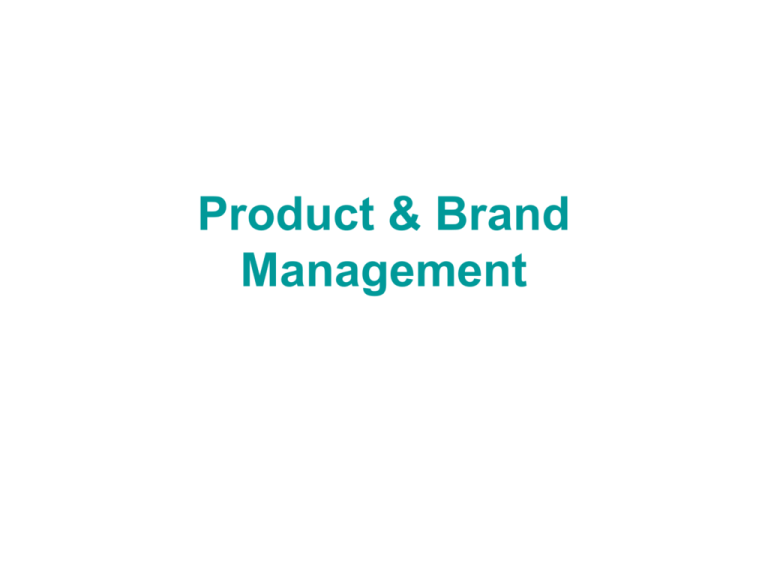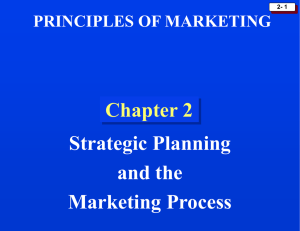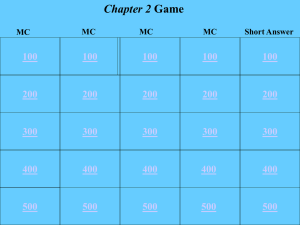
Product & Brand
Management
TATA Global Beverages
TATA Global Beverages (formerly Tata Tea) is
poised to hit kids street. The beverage company,
which till date has been been focusing only on the
adult population, is looking to introduce children food
products as part of its strategy to diversify into
foodspace, which is beyond beverages. The company,
which has grown inorganically over the past few
years, is also open to the idea of acquisition in the
foodspace.
Talking to ET, RK Krishna Kumar, vice-chairman of
Tata Global Beverages, said: “We will be looking at
nutritional food and wellness products in the food
category. Nutritious food like fortified candies can be
introduced for children. The kids segment is an area
which we will be exploring. While it may be in both in
the liquid and solid foods category, we cannot
divulge our plans at this point.”
Advertisement
TATA Global Beverages
Elaborating, he said: “Our mission is to provide
products in the market that delivers physical and
functional benefits and satisfying emotional and
well-being needs. Our vision is to be the leading
‘good for you’ beverage company.” He also indicated
acquisition in the beverage space, both in India and
abroad, in the next five years to become a $5-billion
company
by
2015.
The Tata Global Beverages vice-chairman also
indicated that while the company will continue with
innovations in its areas of strength, it will also seek
to partner with others in other beverage segments
aligned with the company’s mission of offering
wellness
and
nutritional
products.
“These
partnerships will either help us build scale or enable
us to acquire interests in new, emerging, fastgrowing
categories,”
he
said.
Incidentally, the company had
already announced a non-binding
memorandum of understanding
with PepsiCo to form a JV. “Our JV
with Pepsi will enable us to
market non-tea liquid bottled
products,” Mr Krishna Kumar said.
• Targets $5-billion turnover by 2015
Our Bureau KOLKATA
TATA Global Beverages (TGB) is targeting a $5 billion (
23,000 crore) turnover and 15% EBIDTA growth by calendar
2015. The growth is proposed to be achieved through
expansion in core markets, ramping up scale in the US and
Russia, introducing innovative products, expanding beverage
categories in India and entering new geographies. At present,
Tata Global Beverages has a consolidated turnover of 5,821
crore.
Along with its plans to grow its business, the company also
has plans to restructure Tetley’s operations, which had joined
Tata Global Beverages in 2000. Tetley is now present in 70
countries in the world with a 28% value share in the UK market.
This was indicated by TGB chairman Ratan Tata at the
company’s AGM on Monday.
Mr Tata said the TGB will make
investments in all its brands and innovation.
“Going ahead, our plan is to make TGB a
global player, addressing new markets in
India and abroad with new products and new
innovations,” said Mr Tata. Incidentally,
TGB’s plan is to enter 100 new countries by
2015.
In the US and Canada, TGB witnessed
a 189% growth in revenues. The company
increased prices of its
In the US and Canada, TGB witnessed a 189% growth
in revenues. The company increased prices of its
products in the UK, Africa and Canada. The company
introduced Tetley Infusions in the Canadian market.
Eight O’Clock Coffee, a brand acquired by TGB in
2005, has emerged as the third largest coffee brand
with a 5% share in the US retail coffee market. Mr
Tata was extremely bullish about Tion, a ready-todrink cold beverage launched in 2008. “Tion has
carved a niche for itself and we are planning to
launch the product across India,” he said.
Mr Tata said the company’s proposed JV
with PepsiCo would be leveraged for domestic and
international distribution of TGB’s products. “We are
now examining how best we can leverage this JV,”
Mr Tata said. The proposal envisages initially
offering existing health and wellness products and
later diversifying into foods with the intent to
address nutritional and lifestyle challenges.
To shareholder queries, Mr Tata said: “We
have not exited Kolkata. We regret we had not been
able to do what we had planned for West Bengal. We
hope to dedicate the Tata Cancer hospital this year
to the people of West Bengal. We have increased our
investments in the cancer hospital, which is coming
up at Rajarhat.”
Product Portfolio Strategy Introduction to the Boston Consulting Matrix
The Business portfolio is the collection of
businesses and products that make up
the company.
The best Product portfolio is one that fits
the company's strengths and helps
exploit the most attractive opportunities.
Product Portfolio Strategy
Contd….
The company must:
(1) Analyze its current business portfolio
and decide which businesses should
receive more or less investment, and
(2) Develop growth strategies for adding
new products and businesses to the
portfolio, whilst at the same time
deciding when products and businesses
should no longer be retained
Methods of Portfolio Planning:
The two best-known portfolio planning methods are
from
1. The Boston Consulting Group and
2. The General Electric/Shell.
In each method, the first step is to identify the
various Strategic Business Units ("SBU's") in a
company portfolio.
An SBU is a unit of the company that has a
separate mission and objectives and that can be
planned independently from the other
businesses.
An SBU can be a company division, a
product line or even individual brands - it all
depends on how the company is organized.
The Boston Consulting Group Box
("BCG Box") /matrix
Using the BCG Box a company classifies
all its SBU's according to two
dimensions:
On the horizontal axis: relative market
share - this serves as a measure of SBU
strength in the market
On the vertical axis: market growth rate this provides a measure of market
attractiveness
By dividing the matrix into four areas, four
types of SBU can be distinguished
Stars - Stars are high growth businesses or products
competing in markets where they are relatively
strong compared with the competition.
Often they need heavy investment to sustain their
growth. Eventually their growth will slow and,
assuming they maintain their relative market share,
will become cash cows.
Cash Cows - Cash cows are low-growth businesses or
products with a relatively high market share. These
are mature, successful businesses with relatively
little need for investment.
They need to be managed for continued profit - so
that they continue to generate the strong cash flows
that the company needs for its Stars.
Question marks/Trouble Child - Question marks are
businesses or products with low market share but
which operate in higher growth markets.
This suggests that they have potential, but may
require substantial investment in order to grow market
share at the expense of more powerful competitors.
Management have to think hard about "question
marks" - which ones should they invest in? Which
ones should they allow to fail or shrink?
Dogs - Unsurprisingly, the term "dogs" refers to
businesses or products that have low relative share in
unattractive, low-growth markets.
Dogs may generate enough cash to break-even, but
they are rarely, if ever, worth investing in.
Using the BCG Box to determine
Strategy
• Once a company has classified its SBU's, it
must decide what to do with them. In the
diagram above, the company has one large
cash cow (the size of the circle is
proportional to the SBU's sales), a large dog
and two, smaller stars and question marks.
• Conventional strategic thinking suggests
there are four possible strategies for each
SBU
(1) Build Share: Here the company can invest to
increase market share (for example turning a
"question mark" into a star)
(2) Hold: Here the company invests just enough to
keep the SBU in its present position
(3) Harvest: Here the company reduces the
amount of investment in order to maximise the
short-term cash flows and profits from the SBU.
This may have the effect of turning Stars into
Cash Cows.
(4) Divest: The company can divest the SBU by
phasing it out or selling it - in order to use the
resources elsewhere (e.g. investing in the more
promising "question marks").
Goals Of Portfolio Management
Portfolio Management is used to select a
portfolio of new or product
development projects to achieve the
following goals:
1. Maximize the profitability or value of the
portfolio
2. Provide balance
3. Support the strategy of the enterprise
Product Management
Process
Product Management Process
• Product management is an organizational lifecycle
function within a company dealing with the planning or
forecasting or marketing of a product or products at all
stages of the Product Life cycle
• Product management (inbound focused) and product
marketing (outbound focused) are different yet
complementary efforts with the objective of maximizing
sales revenues, market share, and profit margins.
• The role of product management spans many activities
from strategic to tactical and varies based on the
organizational structure of the company. Product
management can be a function separate on its own and
a member of marketing or engineering.
Product
Initiation
Feasibility
Design &
Plan
Launch
Development
Testing
Operation
Decommissioning
Product Management Process
Product management is an occupational
domain which holds two professional
disciplines:
1. Product Planning (Inbound)
2. Product marketing (outbound)
This is because
The Product's functionality is created for
the User via Product Planning efforts,
and
The Product value is presented to the
buyer via Product marketing activities
Product
Management
Product
Planning
Product
Marketing
Customer Advocacy
Business Value
Copyright © 2010 Blackblot. All rights reserved.
Product planning:
• Defining new products
• Gathering market requirements
• Building product roadmaps, particularly
Technology roadmaps
• Product life cycle considerations
• Product differentiation
Product marketing:
• Product positioning and outbound
messaging
• Promoting the product externally with press,
customers, and partners
• Bringing new products to market
• Monitoring the competition
Product Management
Function
Product Management Function
•
•
•
A product management Function is a carefully
Planned detailed strategy Of the product from
concept stage moving across different stages
in getting the product to the market up to its
disposal stage
The product management function is the hub
of many activities around the product. In
others, it is one of many things that need to
happen to bring a product to market.
Product management often serves an interdisciplinary role, bridging gaps within the
company between teams of different
expertise, most notably between engineeringoriented teams and business-oriented teams
• While the Product Management function had existed for
many years and is employed at many companies today,
• The roles, responsibilities and activities vary from
company to company, so there is no single “blueprint”
for the function that a company can use.
• In fact, the product management function should vary
from company to company, since each has its own
unique business model.
• In addition, each organization already has processes in
place, so the product management overlay requires a
degree of change management.
• A product manager investigates, selects, develops,
products for an organization, performing the activity of
Product management.
The Product Management
Functions
The Main Functional Areas
DEVELOPMENT
FUNCTIONS
BUSINESS
FUNCTIONS
TESTING
FUNCTIONS
Product management
Functions
Management
Functions
Execution
FUNCTIONS
SUPPORT
FUNCTIONS
1 BUSINESS FUNCTIONS
BUSINESS FUNCTIONS:
• Market analysis
• Business rules
• New Product Ideas
• Requirements
• Coordinate product launches
• Decide product tradeoffs
• Assess cost
• Feasibility
2 DEVELOPMENT FUNCTIONS
DEVELOPMENT FUNCTIONS:
• Architecture and Design
• Coding
• Hardware Design
• Prototyping
• Unit Testing
• Deployment
• Maintenance
– Plan manufacturing
– Manufacture
– Build/Assemble
• Test (quality check)
3 TESTING FUNCTIONS
TESTING FUNCTIONS:
• Test Case Design
• Market Compliance
• Product Quality Assurance
• Product Gap Tracking
• Feed Back Reporting
4 Management FUNCTIONS
Product MGMT FUNCTIONS:
• Project tracking
• Communications Planning
• Scheduling
• Budgeting
• Resource Allocation
• Issue Resolution
5 SUPPORT FUNCTIONS
SUPPORT FUNCTIONS:
• Customer issue resolution
• Defect Reporting
• Customer Training
• Sales Training
6 Execution FUNCTIONS
DOCUMENTATION FUNCTIONS:
• Create all product documents
• Sales Training Materials
• Complete process DOCUMENTATION
• Customer Training Materials
• Online and office help documents
• Additional as-needed documentation
• Execution ,Feed Back & Monitoring of the
product up to End-Of- life.
• Sell and Deliver
• Maintain and Support
• Dispose
Draw backs Of The Product
Portfolio Approach
Draw Backs: Portfolio Approach
1.
2.
3.
4.
5.
It is very subjective some times to maintaining &
balanced the product portfolio.
The Portfolio is unbalanced when there are too
many problem child & dogs, and not enough stars
and cash cows.
The product portfolio approach most of the time
fails to understand individual product ‘s Market
Penetration, Product development, Market
development, Diversification of the product Etc..
Different products in the portfolio has different roles
Enough investments is needed to maintain the
market share of such product. But the portfolio
approach may not considered .
Most Companies will not have resources to invest
in many trouble child Products.
6.
In assumption that cash flow will be determined by
product’s position in the matrix is weak. Some stars
will show a healthy positive Cash flow as will some
dogs in the markets where competitive activity is low.
7. The analysis ignores interdependence among
products. A dog may complement a star. Customers
may want a full product line.
8. Competitions Reaction are not assessed.
9. These Matrix does not define a market i:e Whole
market or a Segment.
10. The Matrix does not identify the criteria such as
Market attractiveness, competitive Strength and
weighing different Criterion and also does not
suggests which Product to be Build, harvest or
Dropped.
PRODUCT MANAGER :Scopes,
Responsibilities &Authority
PRODUCT MANAGER :Scopes,
Responsibilities &Authority
1.
2.
3.
4.
5.
The product manager will be responsible for
managing the entire product life cycle from strategic
planning to tactical execution.
A product manager investigates, selects, develops,
products for an organization, performing the activity
of Product management.
Develop market requirements, maintain feature
requirements for current & future products by
conducting market research and on-going visits to
customers as well as prospects.
Develop and write product requirements, maintain and
develop all product documentation including
business case, product requirements, Packaging,
pricing and policies.
Analyzing potential partner relationships for the
product and implement a company-wide go-to-market
plan, working with all departments to execute in time.
PRODUCT MANAGER :Scopes,
Responsibilities &Authority
6.
The product manger is responsible for Managing
products through complete life cycle, from strategic
planning to end-of-life.
7. Defines the product strategy and roadmap Establish
product roadmap across multiple product releases
8. Ability to influence cross-functional teams without
formal authority. Should Have excellent team work
skills
9. Build and maintain prioritized feature lists from
requests from partners, customers, internal findings,
existing product analysis, and industry trends
10. Participate in formal product development processes
by working with product development team to provide
guidance
11. Develop product management documentation,
including, product concept proposals, business cases,
formal product requirement specification for each
release, launch plans, product collateral, sales training
PRODUCT MANAGER :Scopes,
Responsibilities &Authority
12. Establish relationships with sales and sales
engineers to position and sell product successfully,
providing training and leadership on strategic
opportunities
13. Work closely with Marketing group to optimize
marketing of product/solutions through all
marketing channels and provide guidance on all
product collateral
14. Support financial requirements of product
management including pricing, budgets and
forecasting. Set pricing to meet revenue and
profitability goals. Also ,Deliver a monthly revenue
forecast
15. Other Functions as assigned From time to time
related to the product by the top management.
16. Work with external third parties to assess
partnerships and licensing opportunities.
PRODUCT MANAGER :Scopes,
Responsibilities &Authority
17. Work with external third parties to assess
partnerships and licensing opportunities
18. Be an expert with respect to the
competition
19. Act as a leader within the company
20. Brief press & analysts and go on press
tour
The Need For A Product
Management system
•
•
•
•
•
Today, challenges faced by product development teams include
globalization, outsourcing, mass customization, fast innovation and
product traceability.
Additionally, organizations are being asked to do more with fewer
resources; product complexity is increasing while product lifecycles
are compressing. Furthermore, to be competitive, manufacturers not
only need to increase the rate of product innovation but also
accelerate time to market, while tightly managing costs and
relentlessly driving quality.
New product development challenges also include external factors
such as product proliferation, consumer awareness, fast-moving
consumer trends and changing government regulations. At the same
time, manufacturers must comply with an increasing number of
standards and regulations.
Equally important, interest in global product development is growing
dramatically, driving new demands for distributed processes,
collaboration, and global data management.
PM systems are gaining acceptance for managing all information
about the corporation's products throughout their full lifecycle, from
conceptualization to operations and disposal. The PLM philosophy
and systems aim at providing support to an even broader range of
engineering and business activities.
• PM enables the entire design and supply
chain to track, document, and report on
important details including design
intentions, considerations, test results,
decision rationale, and compliance
requirements within the context of the asdesigned product configuration.






